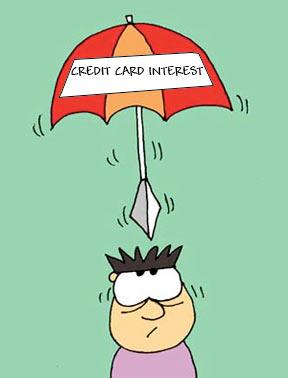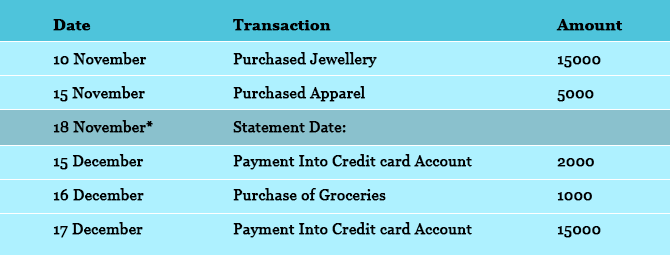
The interest rate charged on your credit card makes your ownership a nightmare if you don't know it in perfect detail. Here's a primer for you
The interest rate charged on your credit card makes your ownership a nightmare if you don't know it in perfect detail.
Broadly the credit card finance charges represent the interest charged on outstanding credit card balances. Finance charges are the most important part of any credit card terms and should never be ignored.
Many credit card holders pay more attention to the annual fees, card-renewal fees, add-on-card fees, etc while applying or using a credit card but actually it is the interest rate that makes your credit card ownership a nightmare if you don't know it in perfect detail.
We take a look at how the finance charges and other fees are calculated for your credit card expenses.
First let us take a look at the most important aspect about the finance charges levied by credit card companies. The finance charges are paid based on a monthly percentage interest rate (say 2.65 per cent) and is calculated on a average daily balance method for most credit cards in India.
This is calculated by the simple formula as follows:
Interest calculated = [(outstanding amount x 2.65 per cent per month x 12 months) * number of days] / 365
Then there is a thing called the grace period, during which the balances on credit card do not attract finance charges provided the credit card holder repays the entire outstanding amount in full with the monthly credit card bill. The grace period varies with every credit card and usually is between 20 to 60 days. It is also called the interest free period.
For example, the HDFC Bank Platinum Plus Card has an interest-free credit period of 55 days. So, a credit card holder whose billing date falls on 4th of the month can spend on her/his credit card from 5th April to 4th May, and her/his bill will be generated on 4th May. Her/his payment due date will be 29th May. Therefore a purchase made on 14th April will have a credit period of 46 days, while a purchase made on 2nd May will have a credit period of 23 days.
The cash advances taken from credit card do not enjoy any grace period and this is applicable for almost every credit card issued in India. So, if a credit card holder withdraws cash using her/his credit card, the interest rate is applied to the amount from the very first day and will apply till the amount is repaid in full.
If a credit card holder doesn't pay her/his bill completely before the due date, her/his entire outstanding balance will attract interest rate and all new spends on the credit card will also attract interest rate until the balances are repaid in full. This essentially means that if a credit card holder doesn't repay her/his outstanding balances in full every month, there is no grace period for her/him. Taking cash advances from the credit card also takes away any grace period.
Another thing that increases the credit card bill very often is the late payment fees. This fees or penalty is levied when the monthly payment doesn't reach the credit card company before the due date. Again this late payment fees vary with credit card and outstanding amount.
For example the HDFC Bank Platinum Plus Card charges Rs 350 as the late payment fees for credit card bills up to Rs 10,000, Rs 500
for bills between Rs 10,000 and Rs 20,000 and, Rs 600 for bills above Rs 20,000. Depending on the outstanding balance this amount can really add up.
Let us now take a look at the method of calculating various charges. Here we assume that there are no outstanding balances before 10 November and the credit card bill has to be repaid before 18th of every month. The credit card company charges 2.65 per cent as monthly interest rate and a late payment penalty of Rs 350.

* Since the payment didn't reach the credit card company on time, entire outstanding balance will attract interest rate and a late payment penalty.
The charges are calculated from the statement date.
Interest on Rs 15,000 @ 2.65 per cent pm from 18 November to 15 December (i.e. for 28 days)
[(15000 x 2.65 x 12 x 28)/365]/100 = Rs 365.91
Interest on Rs 13,000 @ 2.65 per cent pm from 15 December to 17 December (i.e. for 3 days)
((13000 x 2.65 x 12 x 3)/365]/100= Rs 33.97
Interest on Rs 5,000 @ 2.65 per cent pm from 18 November to 17 December (i.e. for 30 days)
((5000 x 2.65 x 12 x 30)/365]/100 = Rs 130.68
Interest on Rs 3,000 @ 2.65 per cent pm from 17 December to 18 December (i.e. for 2 days)
((3000 x 2.65 x 12 x 2)/365]/100 = Rs 5.22
Interest on Rs 1000 (fresh spends @ 2.65 per cent pm from 16 December to 18 December (i.e. for 3 days)
((1000 x 2.65 x 12 x 3)/365]/100 = Rs 2.61
a) Thus total interest = (365.91+ 33.97+130.68+5.22+2.61) =Rs 538.39
b) Late payment charges = Rs 350
c) Total principal amount outstanding = Rs 4000 (Rs 1000 fresh spend + balance Rs 3000 outstanding from last month's billing period)
Hence Total Amount Due = (a) + (b) + (c) = Rs 4888.39 + service tax as applicable on interest and other charges.
This example above will help you get an idea how the credit card company charges interest rate on your credit card outstanding balances. In addition to the interest rates and late payment penalties, cash advance fees (which is usually a percentage of the entire cash withdrawn), over limit fees (which is charged when a credit card holder jumps his credit limit), annual fees and other charges detailed in your credit card terms and conditions are also added if they are due and have to be repaid with the credit card bill.










